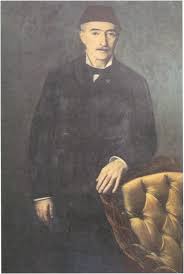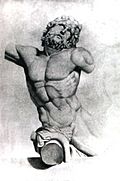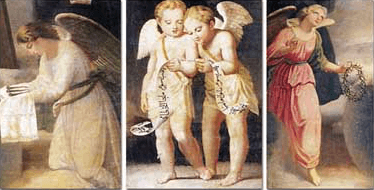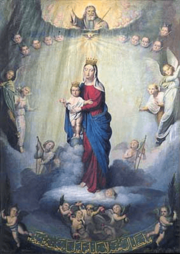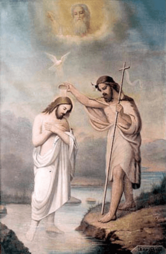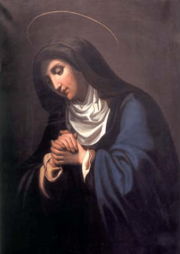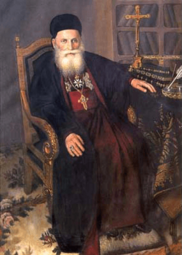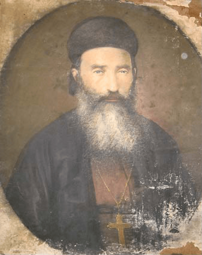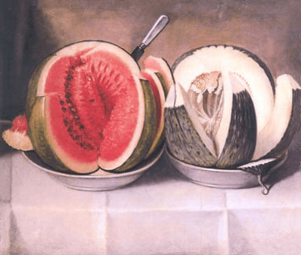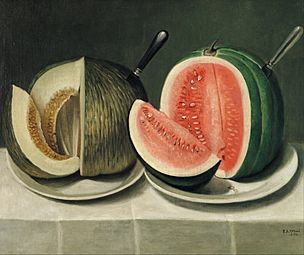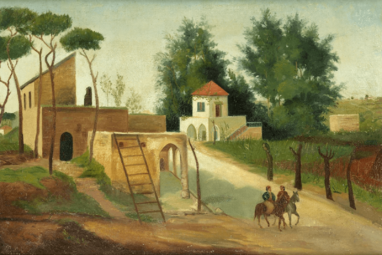Daoud Corm facts for kids
Quick facts for kids
Daoud Corm
|
|
|---|---|
| داود قرم | |
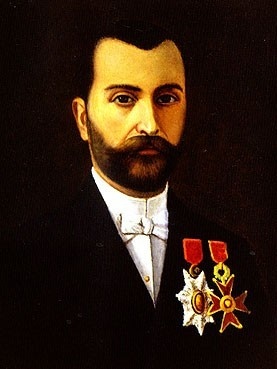
1900 self-portrait
|
|
| Born |
Daoud Corm
26 June 1852 Ghosta, Lebanon
|
| Died | 6 June 1930 (aged 77) |
| Nationality | Lebanese |
| Education | Accademia di San Luca |
| Known for | Painting |
| Spouse(s) | Virgine Naaman |
| Awards | Prize of Honor of Excellence, 1900 Paris Exhibition |
| Patron(s) | Elias Peter Hoayek, Sursock family. |
Daoud Corm (1852–1930) was a very important Lebanese painter. His English name was David Corm. He was the father of Charles Corm, a famous writer and businessman. Daoud Corm also taught and guided young artists. One of his most famous students was Khalil Gibran, a well-known writer and artist.
In 1870, Daoud Corm traveled to Rome, Italy. He joined the Accademia di San Luca, a famous art school. There, he learned from Roberto Bompiani, who was a painter for the Italian royal family. During his five years in Italy, Daoud Corm studied the works of old masters from the Renaissance. Their style greatly influenced his own paintings. He became well-known when he was asked to paint a portrait of Pope Pius IX. After returning to Lebanon in 1875, he painted many portraits of important people, including Abbas II of Egypt in 1894. Daoud Corm also painted many religious scenes. You can find his paintings in churches across Lebanon, Syria, Egypt, and Palestine.
In 1912, Corm opened an art shop called Maison d'Art (House of Art). It was in the center of Beirut. This shop sold art supplies and also had an art studio. It was very successful, showing that more people were interested in art. Corm also showed his paintings in other countries, like Egypt and Europe. He won the Prize of Honor of Excellence at the 1900 Paris Exhibition. He also received the Lebanese Order of Merit and the Ottoman Medal of Glory. Daoud Corm passed away in Beirut in 1930, at the age of 77.
Contents
Early Life and Discovering Art
Daoud Corm was born in 1852 in Ghosta, a town in Mount Lebanon. His family was well-off, and his father was a skilled writer and scholar. Daoud was one of three children.
When Daoud was only nine years old, friars (religious brothers) from the Jesuit College of Ghazir noticed his amazing drawing skills. They encouraged his talent. The friars at the college pushed him to study painting in Rome, Italy.
Learning to Paint in Europe (1870-1878)
To pay for his trip to Rome, Corm sold some of his paintings to a local Maronite church. In 1870, at 18 years old, he traveled by foot to Beirut. From there, he took a French ship to Naples, Italy. He then traveled by train to Rome. He stayed at the Maronite seminary, a religious school, with Elias Peter Hoayek, who would later become a very important church leader and his supporter.
Corm wanted to study with Roberto Bompiani, a famous professor at the Accademia di San Luca. He tried many times to meet Bompiani, but the servants wouldn't let him in. After weeks of trying, Corm got frustrated. He threw down his art portfolio and argued with the servants. Bompiani heard the noise and came out. He saw Corm and his paintings scattered on the floor. The professor picked up one of Daoud's paintings. He immediately saw the young man's talent and decided to teach him. Corm spent several years at the academy. He also visited many museums and churches, copying the works of the Renaissance masters.
On July 24, 1874, Daoud wrote to his family. He told them that his friend, Father Rukoz, would introduce him to Pope Pius IX. Corm wanted to paint the Pope's portrait and send it home. His request was first turned down. But Corm didn't give up! That same night, he drew the Pope from memory. Bompiani was very impressed by this. He showed the finished portrait to Pope Pius, who blessed the painting. This portrait is now kept in the Vatican Library. After his training in Rome, Daoud moved to Belgium. There, he became one of the official painters for the Belgian royal family under King Leopold II.
Becoming a Famous Artist in Beirut (1878-1930)
Between 1839 and 1876, the Ottoman Empire made many changes in Beirut. These changes helped Beirut become a very important port city. Many families moved to Beirut from other cities. When Corm returned to Beirut in 1878, he wanted to work for these wealthy merchant families. To attract them, he used a special trick. He had a photograph taken of himself putting the finishing touches on his portrait of Pope Pius IX. He used this photo as his business card. This showed people that he was a skilled artist with Western training, approved by a very important religious leader.
Among Corm's first important clients were the Sursock family. They were a rich Greek Orthodox merchant family who loved to support art. Corm painted portraits for Khalil Bey Sursock in 1882, Mahjet Sursock in 1892, and Moussa Sursock and his wife Anasthasia Dagher in 1897. Other important people he painted included:
- Hussein Beyhum, a leader of a science group and a politician.
- Jurji Zaydan, a writer and journalist who started the al-Hilal magazine.
- Viscount Philippe de Tarazzi, a scholar and founder of the Lebanese National Library.
- Butrus al-Bustani, a key figure in a literary movement.
- Ibrahim al- Yaziji, a famous language expert and journalist.
Corm helped art become more popular in Beirut. In 1912, he opened his art supply shop, Maison d'Art. It was very successful. Later, it even had a darkroom to develop photos from the first handheld cameras. Corm himself became interested in photography and took pictures of his family.
His Unique Painting Style
When Daoud Corm was studying in Rome, he spent a lot of time in museums. He copied the faces and hand gestures from the works of Renaissance masters. This focus on how the human body looks is clear in his portraits. Corm usually painted people from a three-quarter view. He used soft light against a dark background. He also paid close attention to details that showed what his subjects did for a living or their social status.
Besides portraits, Corm painted a few landscapes and everyday scenes. However, there wasn't a big market for these types of paintings. His everyday scenes are sometimes described as a bit too dramatic or staged. An example is his 1900 painting, Bedouin woman with her child.
Daoud Corm is seen as a pioneer, meaning he helped start something new. Along with other artists like Mustafa Farrukh and Omar Onsi, he laid the groundwork for modern Lebanese art. These artists dared to move away from only religious works. They brought new ideas of originality and freedom of expression to Lebanon's art scene.
Paintings for Churches
Corm's first major client was the Maronite church. This was especially true under the support of Patriarch Elias Peter Hoayek, who had traveled to Italy with him. Corm painted many religious works. You can find these paintings not only in Lebanon but also in Syria, Egypt, and Palestine. Experts say that Corm changed Lebanese religious art. He brought in classical painting styles. This started a new movement of academic art in Beirut.
Gallery
-
The Sacred Heart of Jesus (1880)
-
Painting of Saint Peter (c. late 19th-early 20th century)



